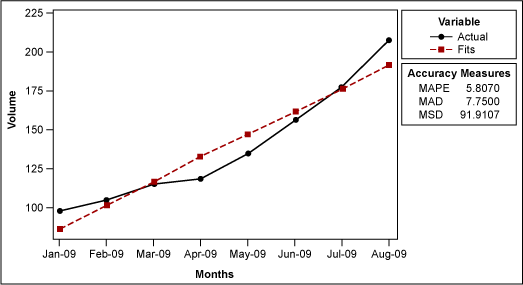Tag: forecasting

Exploring the Benefits of Autocorrelation in Time Series Analysis
Published:To optimize the benefit of your forecasting, you would like your time series values to be independent. Unfortunately, sometimes your values are correlated. This autocorrelation will have an impact on your ability to interpret what the data is telling you. Autocorrelation refers to the correlation between a time series variable and its lagged […]
Read more »
Making Sense of Time Series Forecasting
Published:It is a common scenario: A practitioner has sales data for the past several months and wants to forecast next month’s sales volume. This type of forecasting can help manufacturers and distributors ensure they have enough product to meet customer demands. But how is this forecasting done? Statistical analysis software offers two ways to plot […]
Read more »
How Do You Improve Call Center Forecast Accuracy with Six Sigma?
Published:In an exchange on the iSixSigma Discussion Forums, a representative from a telecommunications firm was interested in learning about what methods are best to improve forecast accuracy at the company’s call center. After some discussion about defining the goals of the project, the responding Six Sigma experts then offered their views about using such tools […]
Read more »
Assessing Forecast Accuracy: Be Prepared, Rain or Shine
Published:Just as people follow weather predictions to know if they should carry an umbrella, organizations use forecasting to predict and prepare for future events. Across industries, companies attempt to determine what will happen – they forecast for product or raw material prices, market demand, exchange rates, and numerous other key metrics. Based on these forecasts, […]
Read more »
Understanding Scatter Diagrams and Correlation Analysis
Published:Six Sigma scatter diagrams and their correlation analyses often debunk management myths. Many times executives assume and/or presume that measures vary together when they do not. Sometimes they assume and/or presume that measures do not vary in concert with one another when they do. For better or worse, budget forecasts are based on these assumptions. […]
Read more »
Improved IT Project Forecasting Through Six Sigma
Published:The various costs of an information technology (IT) project is forecast at the beginning of the fiscal year and usually re-forecast at the end of each month based on the actual spending pattern. Variation in the IT project forecasting process can result in either underspent or overspent budgets. As is true in most processes, variation […]
Read more »
Use Forecasting Basics to Predict Future Conditions
Published:Basic terminologies of time series and forecasting can be difficult to understand. There are four basic learning points: The definition of forecasting Forecasting as a business and communicative process (not a statistical tool) General definitions used in forecasting (regardless of statistical tool) The statistical/mathematical techniques Becoming Aware of the Broad View of Forecasting: Overview – […]
Read more »
Improved Forecasting with Moving Averages and Z-scores
Published:Forecasting is an integral part of business management. The better the forecast, the better management will be able to plan for the future. Although there are many methods for making forecasts, some are better suited than others for particular situations. For short-term forecasting, Black Belts can benefit from analyzing production trends and looking for special […]
Read more »
Army Improves Equipment Management with Lean Six Sigma
Published:With increased budget cuts and dwindling funding, Army organizations are examining how best to manage budgets and stretch dollars to provide the best logistical support to soldiers. Army organizations at Natick, Mass., USA, are using Lean Six Sigma to establish a joint process to improve the accuracy of the soldier equipment support budget proposals by […]
Read more »
Management Assessment for Competitive Advantage
Published:A management functional assessment model (MFAM) can help organizations attain and sustain a competitive advantage in the marketplace. The model aids managers in determining the key activities to address in order to improve corporate efficiency and effectiveness based on satisfying stakeholders. And it does it via an easy-to-use scorecard. While using Six Sigma’s DMAIC methodology […]
Read more »